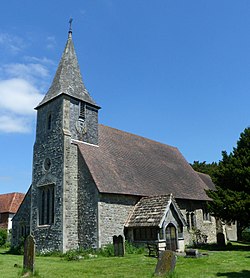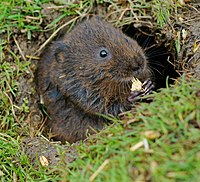Horne, Surrey
| Horne | |
| Surrey | |
|---|---|
 Church of St Mary the Virgin | |
| Location | |
| Grid reference: | TQ334433 |
| Location: | 51°10’27"N, 0°5’33"W |
| Data | |
| Population: | 811 (2011) |
| Post town: | Horley |
| Postcode: | RH6 |
| Dialling code: | 01342 |
| Local Government | |
| Council: | Tandridge |
| Parliamentary constituency: |
East Surrey |
Horne is a tiny, rural village in the south-east of Surrey, three miles from the Sussex border to the south, and six miles from the border of Kent to the east. The parish includes the hamlet of Newchapel, where the British Wildlife Centre is found. Eastern fields forming a narrow part of the parish are split by the A22 road, a main road to East Grinstead across the county border in Sussex.
The civil parish covers 3,506 acres and is centred four and a half miles east of Horley, four miles west of Lingfield, and eight miles south of Oxted.
History
A British Celtic) gold coin has been found in Horne, but is more probably a mark of transit than of settlement. Otherwise there are no prehistoric remains, such as are usually found in other Wealden parishes. Horne must have owed such importance as it had later to the iron industry.[1]
The earliest reference to Horne by name was in the 12th century. Horne had a chapelry and manor but did not become a parish until 1705, from the southernmost part of Bletchingley parish.[1]
Mr. Stileman, who was instituted parson in 1728, bought a house near the church, but this was afterwards bought by the parish for a workhouse, and so continued to be used until the Poor Law Amendment Act 1834. Horne Common was inclosed by an Act of 1810 and an order made on 14 April 1813. Jesus College, Cambridge parted with Horne Court Manor in 1891 to allow a parsonage house to be built instead.[1]
Church
The parish church in the heart of the village is St Mary the Virgin. It was heavily restored in the Victorian period but retains mediæval features. It has 14th- and 15th-century windows. The south door dates from 1250, and there is a 14th-century oak screen and 15th-century chancel beams. Considerable restoration was undertaken in 1880, which stripped the building of almost all its archaeological interest and completely destroyed its early history.
The oldest feature now remaining is the south doorway, which dates from the middle of the 13th century, but this may possibly have been inserted in the walls of a 12th-century nave. A slight inclination of the chancel to the north shows rebuilding of the east end of the church, but here again the absence of any original detail earlier than a 15th-century rood stair in the west end of the south wall makes the dating of this rebuilding, if indeed it ever took place, a matter of conjecture.[1]
About the hamlet

Airfield and barrage balloon site
A temporary airfield was established to support the Normandy Landings in early 1944 on farmland straddling Bones Lane. It was constructed in three months and used for just seven weeks from May to June 1944. Thereafter it served as a balloon site for a month against the threat of V-1 rockets, and was returned to farmland in 1945.[2]
British Wildlife Centre
The British Wildlife Centre lies in the east of the parish, and has a collection of over 40 species of wildlife. The centre, developed on the site of a former dairy farm, opened in 1997, and participates in captive breeding programmes.[3]
Outside links
| ("Wikimedia Commons" has material about Horne, Surrey) |
- British Wildlife Centre
- Horne: A Vision of Britain Through Time
References
- ↑ 1.0 1.1 1.2 1.3 A History of the County of Surrey - Volume 4 pp 291-296: Parishes: Horne (Victoria County History)
- ↑ A Vision of Britain through time University of Portsmouth and others
- ↑ British Wildlife Centre
